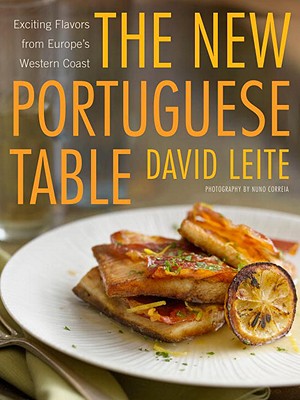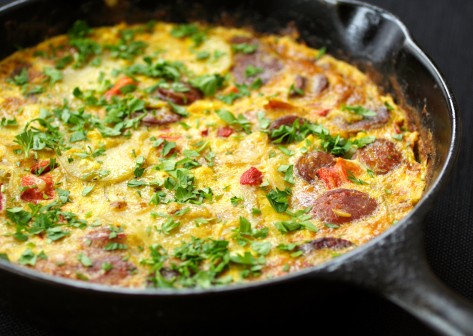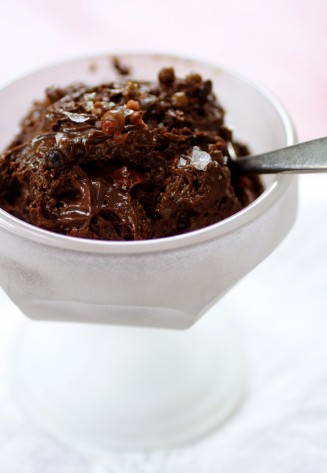Crowd-Pleasing Portuguese Food

THE NEW PORTUGUESE TABLE
Exciting Flavors from Europe’s Western Coast
by David Leite
Clarkson Potter
256 pp. $32.50
It’s difficult to please everyone equally in a cookbook club with every cookbook we choose. Each of us has favorite ingredients and flavor combinations, and even cooking techniques that we’re drawn to. But The New Portuguese Table came pretty darn close.
Several members appreciated the fact that the ingredients weren’t too difficult to gather, which hasn’t been true of all of the books we’ve done, and almost everyone enjoyed the meals they made from the book. Several members, myself included, who wrote to the author on his site (Leite’s Culinaria) with questions about this or that appreciated the author’s accessibility and responsiveness.
For myself, I loved the journey the book took me on—from flavors that went from rustic and simple (egg tortilla cooked in a cast-iron skillet) to rich and elegant (chocolate mousse garnished with sea salt and cracked pink peppercorns); and from the exotic and palate-challenging (green olive dip) to the surprisingly familiar pot likker−soup bean−cornbread−pork product combination (Azorean kale, sausage, and bean soup made hearty with ham hock and eaten with corn bread). It also took me on a journey to my liquor cabinet to create a cocktail using one of the Portugal’s most famous exports: port.

Sausage Tortilla from The New Portuguese Table

Chocolate Mousse from The New Portuguese Table
Altogether DCCC members tried probably 40 of the 100 recipes in the book, and most all were liked, if not loved. If I were to list all the recipes that we liked, it would make for a boring review. Instead, below, I’ve listed just the highlights.
Little Bites
From my foray into the “Little Bites” chapter, I’ve concluded that the Portuguese excel at drinking foods—a sign of a highly evolved culture if there ever was one. Though the recipe for Fried Cornmeal, adored by all unanimously, is found in the “Breads” chapter, I stuck it here because it is perfect with a glass or wine or beer.
Spicy Pumpkin Seeds
Salt Cod and Shrimp Fritters
Green Olive Dip
Beef Turnovers
Shrimp Turnovers
Fried Cornmeal
Soups
Cilantro Bread Soup with Poached Eggs
Green Soup
Lemon-Mint Chicken Soup
Azorean Kale, Sausage, and Bean Soup—the Hearty Version
Main Dishes
My own favorite dish in the entire book falls into this category: the Alentejan-Style Pork with Clams. But then I seem to be drawn to dishes that combine meat and seafood– jambalaya, paella. This dish gets its complex flavors from a relatively few but important key players: the Amped-Up Red Pepper Paste, copious amounts of white wine, and the marriage of land and sea. While the wine sets it firmly in the European cooking tradition, the use of chiles and cilantro conjure cuisines of elsewhere. And that is perhaps one of Portuguese cuisine’s unique attributes.
Alentejan-Style Pork with Clams
Spicy Azorean Garlic-Roasted Pork
Seared Skate in Garlic-Pepper Oil
Grilled Chicken Slathered in Hot Sauce
Mini Lamb Meatballs
Duck Risotto with Ham and Sausage
Sausage Tortilla
Sides
Sweet-Sour Carrots
Sautéed Chestnuts, Onions, and Bacon (use fresh chestnuts)
Grandma Costa’s Dressing and a creamy potato dressing that incorporates the turkey liver
Breads
The corn bread is fun to make because it is yeasted as compared to the typical American quick-bread version. Julie Peterson, a club member in the Denver chapter of DCCC, thinks the Presunto and Cheese Loaves are delicious, and likes the concept of adding sausage and bits of cheese into bread dough. She hopes to incorporate the recipe into her everyday cooking, adding other ingredients that she may have at hand into bread dough.
Corn Bread
Presunto and Cheese Loaves
Sweets and Liqueurs
There is a huge range of flavors and textures and sweetness levels in this chapter—enough to please all tastes. The Orange Cake is subtle and delicate, the Chocolate Mousse, bold and rich. The Milk Liqueur, though a bit sweet for my taste, was a hit with everyone else. (Liqueurs are meant to be sweet, however, so perhaps I’m just not a big liqueur fan.) And the Sweet Lemon and Black Olive Wafers? An unexpected and delicious mix of sweet and savory, balancing them somewhere between a cracker and a cookie.
Orange Cake
Chocolate Mousse
Milk Liqueur
Sweet Lemon and Black Olive Wafers
Sundries
One member feels that the recipe for beef stock was the best she’s ever used, saying that roasting the vegetables and meat first, before adding the liquid, makes all the difference.
Piri-Piri Sauce
Milk “Mayonnaise”
Amped-Up Red Pepper Paste
Beef Stock
What wasn’t liked?
One of our members was less excited about this book than others. (She admitted that she doesn’t like kale or seafood, and seemed less engaged in the book for this reason; note, however, that there are plenty of other options.) Nonetheless, she LOVED the Piri-Piri Sauce and puts it on everything she eats. She likes it so well that she’s planning to grow extra chili peppers in her garden next year.
Another member didn’t care for the Grilled Chicken Breasts with Spicy Coconut Sauce or the Fava Bean and Fennel Salad but did like the Spicy Azorean Garlic-Roasted Pork.
I didn’t care for the port-prune sauce served with the pork tenderloin.
Jenn was initially miffed when after reading enticing descriptions of foods in the introductory section titled “Portugal Parsed: A Quick Regional Gastronomical Tour” she discovered that many of those same foods were not represented with recipes in the book. Once she got into the main part of the book, however, and began trying the recipes, she became a fan. I admit I felt some disappointment too when I realized that not all of the dishes referenced in “Portugal Parsed” were in the book, but soon forgot this disappointment once I began cooking from the more than ample selection of recipes. Those recipes mentioned but not included? All the more reason, I suppose, to visit Portugal.
The New Portuguese Table is Not All Just Good Recipes
It’s a good read, too. If you take time to read the introductory sections and the recipe headnotes, you’ll get some good insights into Portugal, its cuisine and people. From reading “The Portuguese Pantry,” for example, I learned that cilantro, an herb I previously associated with Mexican and Asian cuisines, is the most popular herb in Portugal. According to Leite, the use of cilantro is one of the great differences between Portuguese and Spanish cooking.
Leite used to teach food writing, and may still. His skill as a writer is evident throughout. I particularly like this headnote for Mini Chicken Pies (empadinhas de galinha), where the writing rule of don’t “tell” but instead “show” through “telling details” is expertly used. Instead of telling you the pies are delicious, it’s his description of their smell and of what the townsfolk do that tell you the pies are delicious. ’Cause how could they be otherwise, given the last line of the headnote?
In the quaint walled city of Estremoz, I happened upon a small bakeshop facing the town square. It was almost noon, and I was famished. Inside, in the glass case, were piles of chicken pies—an anomaly in this pork-rich region. Just out of the oven, they filled the shop with a rich, herby smell. I bought a few and sat in the park—just in time, too, as the townspeople, probably called by the aroma, descended upon the place.
